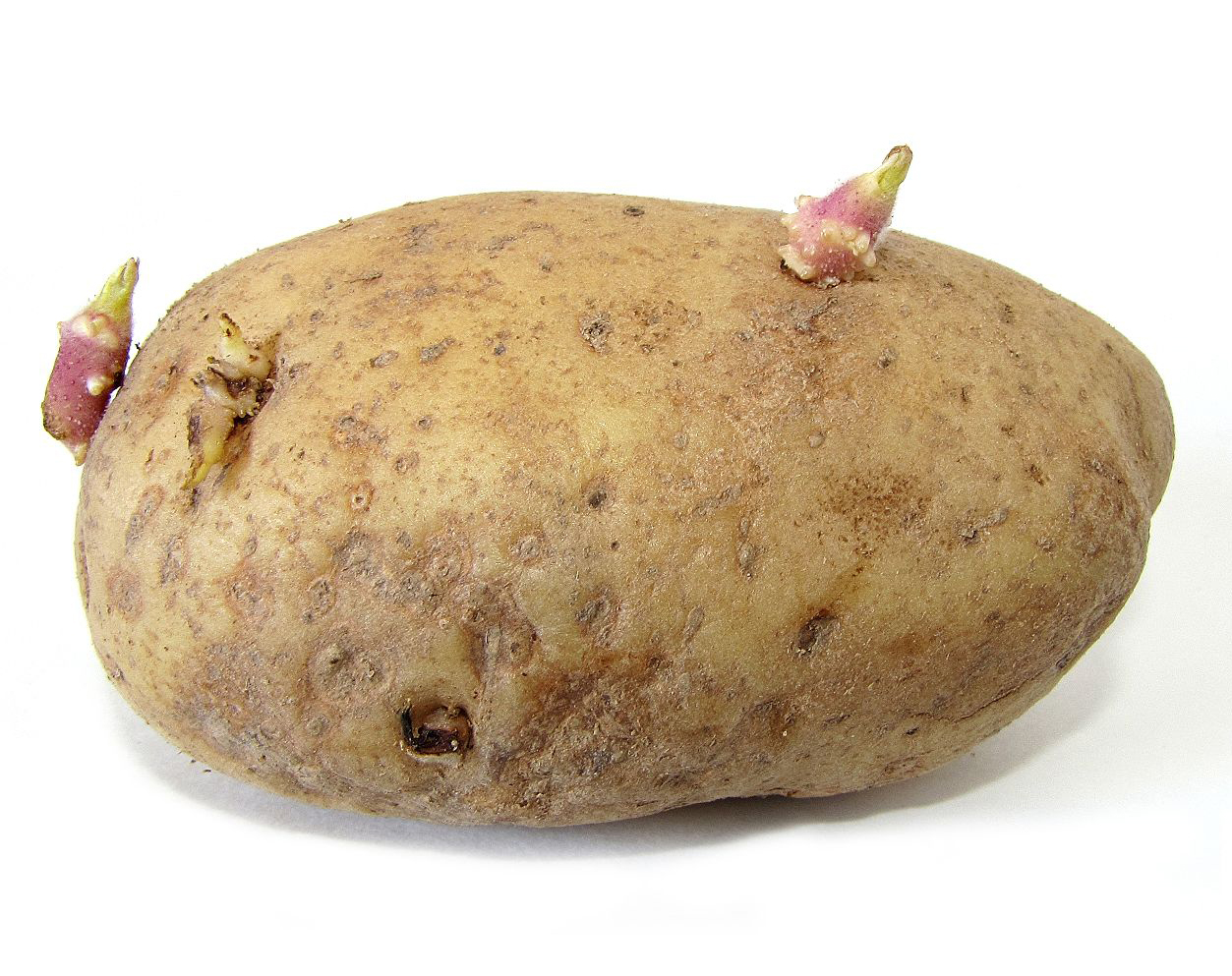The potato is not a root but a storage area that is part of the plant’s underground stem. Vigorous potato plants that have plenty of sunlight, water, and nutrients from the soil produce more energy than the growing plant can use at one time. The plant stores the excess energy in oval packages, called tubers (the potatoes). These tubers provide the plant energy to regrow in the spring. When the greenery starts to wither and turn brown, the potatoes are ready to harvest.
After they are harvested, potatoes can be stored for 2-3 months and will remain in a dormant state if kept in a cool, dark location. When moved to a warmer place, the potatoes will begin to sprout in one to three weeks. Sprouts grow from the “eyes” of the potato, which are actually nodes on this enlarged, underground stem. Each node is capable of developing into a branch that can grow up through the soil and emerge into a green, leafy shoot. As the branches grow, they use up the energy from the original seed potato, which will shrink and shrivel as its starch is consumed. Soon the branches of the plant will grow bushy and have many new leaves that all produce energy through photosynthesis. At this point, new potatoes will begin to form on the underground sections of the branches that grew upward from the seed potato.
Potatoes produce more pounds of protein per acre than corn, rice, wheat, or oats. They are packed with nutrients, low in fat, generous in bulk and efficiently packaged in their own skins. They can be prepared in many different ways and are delicious.
Potatoes were first grown by ancient tribes living in the Andes Mountains of Bolivia and Peru as early as 200 A.D. Archaeologists have found pictures of potato plants in designs on ancient pottery. The ancient people preserved the potatoes by trampling them and then drying them.
Even though potatoes were first grown in South America, people in North America did not start eating them until after they became a popular food in Europe. European explorers carried potatoes from South America to Europe in 1570. About 150 years later, the rulers of several European countries ordered their people to start growing potatoes. In Ireland, potatoes became a staple food for the people. In the 1840s disease wiped out the potato crop in Ireland for two years in a row. Many Irish people moved to America then, because they had no food to eat.
Today, China produces more potatoes than any other country in the world. In the mountainous regions of northern China, potatoes are both a staple food and an important source of income for rural households. In neighboring India, potatoes are less of a rural staple, but they are an important cash crop, providing significant income for farmers. Indian farmers grow potatoes during the winter season when days are shorter. India, Russia, and Ukraine follow China in production, and the United States is the fifth largest producer of potatoes globally.2
Potatoes are grown across the United States. The biggest potato-producing states are Idaho and Washington. Over half of the potatoes produced in the United States are sold to processors to make French fries, chips, and other products.2 A large portion of the remainder goes to the fresh market. Before they go to market, potatoes are graded according to size and quality. The price of the potato depends on how it looks and how much it weighs.
There are thousands of varieties of potatoes. Potatoes come in different colors, including white, red, russet, yellow, and blue. Different varieties also mature at different times and can be broadly grouped as early-, mid-, and late-season potatoes. Yukon gold is a common early-season variety that matures in approximately 90 days, although new potatoes can be harvested as early as 60 days. Russet Burbank is one of the most common potato varieties, and it is a long-season variety, taking 120-140 days to mature. Potatoes are an excellent plant to grow in a school or home garden. The plants grow quickly, and it is exciting to unearth tender, new potatoes that can be turned into many familiar and tasty dishes.
